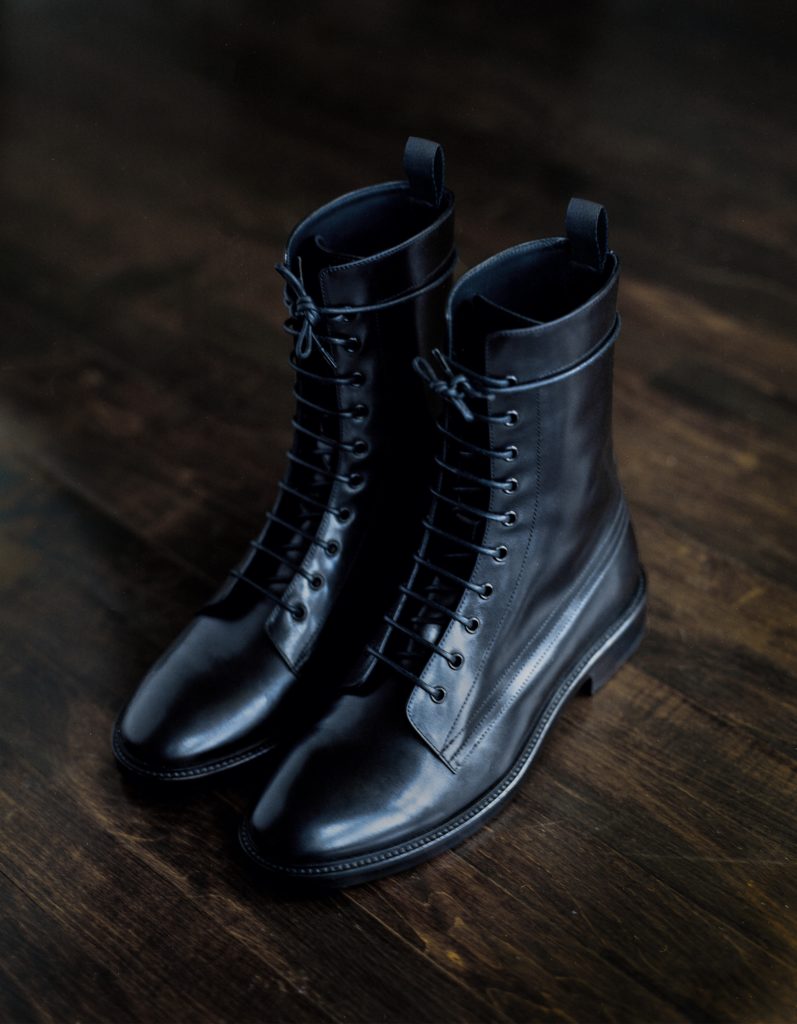It’s Hard to Make It as a Canadian Fashion Brand— These Designers Are Using Social Media to Help

When Lil Huddy posted a photo of himself wearing a pair of Unknown Articles black suede Chelsea boots on Instagram, flashing them to his 12 million followers, the founders of the small Canadian footwear company were somewhat shocked. “We don’t really know how he found them,” says Cameron James, who co-created Toronto-based Unknown Articles with David Brown in 2019.
James and Brown say the 19-year-old singer and TikTok star must have discovered their rock-inspired leather footwear through a friend or stylist, because they certainly did not have an influencer strategy in their budget.

Instead, the duo relies on enthusiastic Reddit forums, word of mouth and a modest Instagram following to sell their boots. To further keep their overhead down, James and Brown also do much of the brand’s photography and website coding themselves. “We want to be as lean as possible and keep a bit more cash on hand,” says James.
That frugality has helped their business survive the pandemic when nearly 60,000 Canadian businesses shut their storefronts. Unknown Articles is one of several Canadian fashion start-ups using a recipe of low-cost, mostly virtual marketing and sales strategies to hedge against the country’s long-underfunded fashion industry—which has been especially pilloried by recent supply chain issues, inflation and the expiry of some government pandemic relief subsidies. For many brands, social media and e-commerce are lifelines in a notoriously harsh landscape.
Canada’s underfunded fashion industry
James and Brown, both 25, work full-time jobs at other companies—in sales and finance, respectively—to fund their business in the hopes of it one day becoming their main source of income. They have their work cut out for them: Canadian designers have long been asking for more support and funding, and outside of Quebec, they still struggle to secure provincial grants allocated to other creative industries like music, arts and film.
The lack of support has made it difficult to foster homegrown talent, and has made it common practice for this generation’s top Canadian-born designers, like Erdem Moralioglu or Aurora James, to relocate and hone their craft in places with a more developed fashion scene, like London, Los Angeles or New York.
But it wasn’t always this way. In the 1970s and ’80s, Canada had a vibrant fashion and manufacturing scene, and plenty of clothes worn by Canadians came from Toronto’s Spadina Avenue or Winnipeg’s denim factories. While the bulk of textile jobs were situated in Quebec and Ontario, the industry had steady growth in 1970s and early 1980s on par with the country’s manufacturing sector.
In 1974, the Fashion Designers Association of Canada was founded in an effort to promote local designers and create awareness around the industry’s contributions to the Canadian economy. Designers like Alfred Sung, Linda Lundström, Simon Chang, Hilary Radley and Wayne Clark were household names.

But recommendations from researchers for the Canadian ministry to gradually phase out domestic textile and clothing industries starting in the late 1970s stung. The logic was that Canada couldn’t compete with the larger, overseas textile factories that were steadily taking over the market, and funding would be better directed towards less-competitive industries. By 2003, Canada removed all tariffs from 48 developing countries, including Bangladesh and Cambodia, increasing the amount of cheaper imported clothing. In 2010, around 19,000 Canadians were making clothes—a huge drop from the 94,260 workers in 2001. The loss of domestic jobs had ripple effects: Government data shows that manufacturing sales of clothing totalled $2.3 billion in 2010, down from $8 billion in 2002. About 95 per cent of apparel bought in Canada now is imported, according to government data.
Toronto Fashion Week, a biannual event and perhaps the biggest recurring exhibition of fashion in the country, was cancelled indefinitely in 2020 after years of struggling to retain sponsors. At the same time, more designers were realizing—as they had been for the last few years—that a strong online presence is much more effective for driving sales. “The goal is to get our business to a point where we don’t have to spend too much on marketing our boots to make them sell,” says James.
How social media and e-commerce is helping designers
Social media has played a huge role in putting Canadian creators on the map and has changed the way celebrities and consumers alike discover brands. Toronto-based designer Kathryn Bowen was thrilled when she was recently contacted by a member of Kim Kardashian’s team after the beauty mogul saw Bowen’s mesh dresses on Instagram. Bowen was asked to make three custom dresses for Kardashian’s latest fragrance campaign—which the reality star recently teased to her 285 million Instagram followers—and she has since signed deals with Nordstrom and Ssense. Another Canadian designer, Sid Neigum, reportedly sold out of his purple laminated trench coat after Kylie Jenner posted it on Instagram and was photographed wearing it in public.
While the endorsement from Lil Huddy has helped Unknown Articles, James and Brown say they’re still feeling the pressures of Canada’s tight marketplace as they build their business. Unknown Articles’ boots are at a high price point—a pair of lace-up ones from its first collection goes for $625—which limits its customer base. But their digital-first business model paired with a growing appetite for local designers is a formula they hope pays off. Indeed, research from McKinsey & Company’s State of Fashion 2022 report shows that more consumers globally are interested in sustainability and knowing where their garments are made, and want to move away from fast-fashion retailers known for environmentally damaging practices. Many of these conscious consumers are also using “digital environments,” like social media and online storefronts, to shop.
“People wanted something that represents Ontario and Canada”
Toronto-based designer Warren Steven Scott knows this firsthand. Scott’s colourful acrylic earrings—contemporary Indigenous designs inspired by Salish motifs—have become social media catnip since he first started making the accessories four years ago. Scott, who is a member of the Nlaka’pamux Nation whose territory is in present-day B.C., went to Ryerson University for fashion design. But he soon realized that designing, producing and selling entire clothing collections had too much overhead cost for a new designer. So, he pivoted.
He first showed his earrings at Indigenous Fashion Week Toronto in 2018 and later held a pop-up sale at the Toronto storefront of Comrags. He realized he was onto something when his first batch of product sold out within days. Scott began selling his creations online and promoting them on social media. Because they were easier and less time-consuming to produce than garments, he could make more earrings as needed and quickly ship them out in the mail.
“What I’ve learned since launching is that the earrings really resonate with customers and it’s created this community of people both on- and offline,” he says, giving an example of two people who started talking in a Vancouver coffee shop because they were both wearing his recognizable designs. “And if someone posts a selfie wearing the earrings on Instagram, we [often] direct message each other and I ask if I can repost the image… Something that’s been really key to my success is how I’ve stuck with a core product that is accessible.”

During the pandemic, when many people turned to support local businesses even more, Scott’s designs “truly took off,” as Vogue puts it, thanks to the power of the internet: U.S. Secretary of the Interior Deb Haaland sported a pair and tons of everyday fans took to Instagram to share snaps of them in their accessories, too. Through word-of-mouth, social media exposure and profiles in international magazines like Cosmopolitan and New York Magazine, sales increased—largely online.
Scott estimates his business is now 70 per cent e-commerce and 30 per cent wholesale; his designs are stocked in select boutiques, museum gift shops and even Simons. Out of his online sales, about a quarter comes from social media alone. Now that his business is growing, he’s moved to a larger work studio and has recently expanded into making clothing.
Shelby Johnston has also experienced the impact of social media on increasing her brand awareness. She was still a student at the University of Windsor when she and her business partner Mallory Martin listened to Alex MacLean, the founder of East Coast Lifestyle, give a presentation about his Maritime-themed comfy clothing line in one of their classes in 2016. When they noticed that their home province had no equivalent, the pair designed a black and white crest, decorated it with six trees and five waves, wrote on it “Best Case Ontario,” and imprinted it on 25 hoodies. They sold out in a matter of days. “People wanted something that represents Ontario and Canada,” says Johnston.
Best Case Ontario recently celebrated its five-year anniversary, and Johnston says their business strategy has changed significantly since 2016 to adapt to the times. They used to rely primarily on pop-up shops, consignment contracts and in-person delivery to sell their apparel. When the pandemic complicated those ventures, they created an online storefront which Johnston says boosted overall sales since cosy sweats and online shopping were primed for the pandemic.
Johnston says being digitally savvy is what helped her company thrive in the past 22 months, and believes it will help carry them post-COVID. “You also have to be smart with money,” she adds, “and hone in on what your brand is.”









